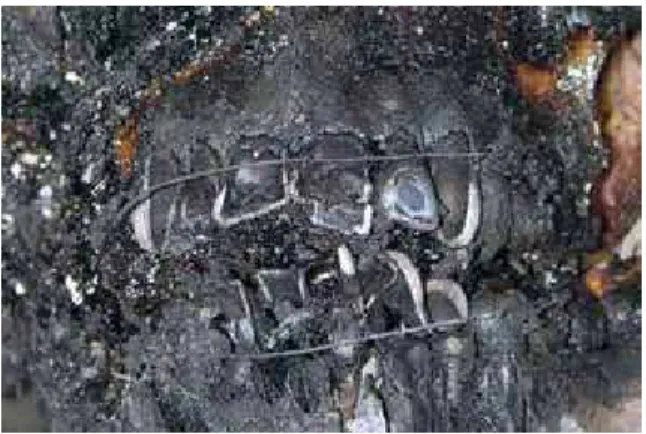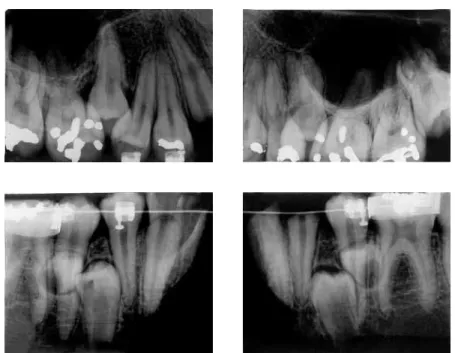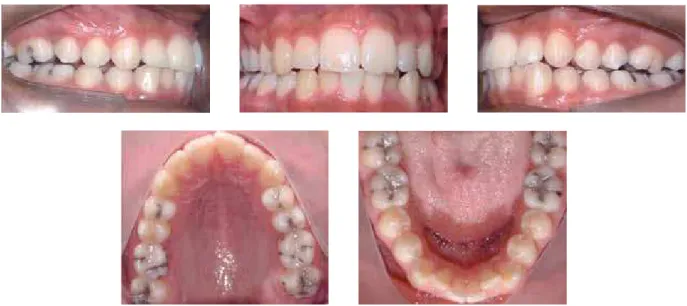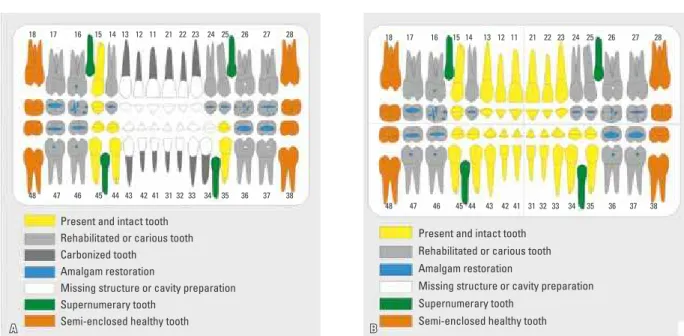Use of orthodontic records in human
identification*
Rhonan Ferreira da Silva**, Patrícia Chaves***, Luiz Renato Paranhos****, Marcos Augusto Lenza*****, Eduardo Daruge Júnior******
Objective: This study describes a forensic case of incinerated remains that were identified using information found in his orthodontic records. Method: Incinerated remains of a man were found inside a car. After forensic crime scene investigation and postmortem and radio-graphic exams in the Forensic Department, forensic experts found that the victim had a fixed orthodontic appliance, supernumerary teeth in all quadrants, partially erupted third molars and amalgam restorations in some surfaces of several teeth. As the individual’s soft tissues were substantially destroyed, identification using fingerprints was not the ideal choice. After orthodontic records were handed in by the family, his clinical chart, radiographs, intra- and extraoral photographs and impressions were analyzed, and these data were compared with previously collected information. Results and Conclusions: Forensic dentistry examination re-vealed 20 concordant points in specimen examination and orthodontic records, which enabled the establishment of a positive correlation between the cadaver under examination and the missing person and eliminated the need for further analyses (DNA tests) to identify the victim.
Abstract
Keywords: Forensic anthropology. Forensic dentistry. Orthodontics.
** MSc in Forensic Dentistry, School of Dentistry of Piracicaba, Campinas University (FOP-UNICAMP), Brazil. Professor, Forensic Dentistry, Paulista Uni-versity, State of Goiás (UNIP-GO), Brazil. Criminal Examiner, Forensic Police Department, Goiás, Brazil.
*** MSc in Comprehensive Dental Clinic and Restorative Dentistry, FOP-UNICAMP, Brazil. Professor, Comprehensive Care, UNIP-GO, Brazil. Specialist Degree in Orthodontics, School of Dentistry, Federal University of Goiás (FO-UFG), Brazil.
**** PhD, Buccodental Biology - FOP/UNICAMP/Piracicaba. Head Professor, Graduate Dentistry Program, Orthodontics, UMESP/São Bernardo do Campo. ***** PhD in Orthodontics, University of Nebraska, USA. Head Professor, Orthodontics, FO-UFG, Brazil.
****** Professor, PhD in Forensic Dentistry, FOP-UNICAMP, Brazil.
* Study conducted as part of the requisites to obtain the degree of Specialist in Orthodontics of the School of Dentistry of the Federal University of Goiás (FO-UFG).
intROduCtiOn
Orthodontics is the specialization whose pur-pose is the prevention, supervision and guidance of the development of the masticatory system, the cor-rection of dentofacial structures, including the con-ditions that require tooth movement for their treat-ment, and the establishment of esthetic harmony of the maxillary and mandibular structures of the face.
FIGURE 1 - Incinerated anterior teeth with missing brackets, lost with buccal enamel, and orthodontic wire.
In Brazil, dentists are required to adequately store and keep all dental documents produced during the treatment of their patients, as estab-lished in Paragraph 5 of the Brazilian Code of Ethics in Dentistry. The storage of dental records enables the orthodontist to follow the clinical development of treatments under way and those already completed at any time. In Forensic Den-tistry, the importance of these stored materials is associated with both issues of professional de-fense, in cases of lawsuits against dentists,8 and the identification of skeletonized, putrefied or incin-erated cadavers.11,12
Considering the responsibility of orthodontists in the practice of their profession and the richness of information found in orthodontic records, this study describes a forensic case of an individual whose remains were incinerated and whose iden-tity was positively established using information from a panoramic radiograph and intraoral pho-tographs taken due to an orthodontic treatment.
CASE REPORt
In August 2006, the incinerated remains of a man were found inside a car. After the forensic crime scene investigation, remains were taken to the Forensic Department of the region for routine postmortem examination, such as the determina-tion of cause of death, identificadetermina-tion of instrument or means of death and, if possible, establishment of the victim’s identity.
The friability of remaining hard tissues, exac-erbated by incineration, led us to resect the man-dible and maxilla so that the characteristics of the dental arches could be better evaluated. Although
the four quadrants, partially erupted third molars and amalgam restorations in several tooth surfaces (Figs 2 and 3).
Concurrent to the examination of remains, po-lice investigations advanced and found informa-tion about the probable victim, who had anthro-pological characteristics compatible with those found in the cadaver under study. As soft tissues were severely destroyed, identification according to fingerprints was not the ideal choice. There-fore, relatives of this missing person were asked to search for any type of medical or dental records or photographs that might support identification.
A
C B
a radiographic interpretation report and a pair of plaster impressions. The date of these documents was of 2005. All dental information and charac-teristics in the orthodontic records were grouped in a single dental diagram.
diSCuSSiOn
Forensic literature has several case reports of incinerated, skeletonized or decomposing re-mains that were identified by analysis of dental characteristics,5,6 a technique that may be
associ-FIGURE 2 - Occlusal (A) photo and right (B) and left (C) lateral photos of the maxilla show amalgam
restorations in teeth 17, 16, 14, 24, 25, 26 and 27, and presence of brackets on teeth 14, 15 and 25.
FIGURE 3 - Postmortem radiographs show supernumerary teeth in maxillary and mandibular arches, as well as brackets and bands in mandibular molars.
FIGURE 5 - Intraoral photographs taken for orthodontic treatment (2005).
ated with other human identification methods.2 The good results obtained with the use of this technique may be assigned to the considerable resistance to fire of teeth and dental materials,7 as well as to the information found in documents produced during dental care, such as dental charts, radiographs and photographs.
Forensic dental identification may be classified as a comparative method to determine an individ-ual’s identity. For didactic purposes, it may be di-vided into three phases: (1) exam of the cadaver’s dental arches; (2) exam of dental records; (3) and forensic dental comparisons.9 In the first phase, all the particular characteristics found in the ca-daver’s dental arches are recorded and associated with present or missing teeth, restorations (sur-faces and materials), prosthesis, endodontic treat-ments, pathologies, anomalies, and other features. During the exam of dental records, experts collect all data about treatments performed or planned that were recorded by the dentist in the dental charts, associated with the information produced by complementary tests, such as radiographs, pho-tographs and impressions. During the last phase, the data obtained in the first two phases are com-pared using the same reference points (surface,
tooth, quadrant) and a qualitative and quantita-tive analysis of the particular dental characteris-tics (Fig 6).
In the case described here, forensic dentistry comparisons revealed that a total of 20 relevant comparison points were identified, associated with the presence of supernumerary teeth be-tween teeth # 15/16, 25/26, 34/35 and 44/45 (Teeth are described using the FDI numbering system), in addition to shape and site of amal-gam restorations in most of the posterior teeth. These concordant comparative points showed a positive correlation between the cadaver under examination and the identity of the missing per-son and eliminated the need to perform other exams (DNA tests) to establish the victim’s identity. Genetic testing provides extremely re-liable results, but falls short of the usefulness of forensic dental examinations when cost, time and structure necessary to use the technique are taken into consideration.10
B A 18 48 17 47 16 46 15 45 13 43 21 31 24 34 27 37 28 38 14 44 11 41 23 33 26 36 12 42 22 32 25 35 18 48 17 47 16 46 15 45 13 43 21 31 24 34 27 37 28 38 14 44 11 41 23 33 26 36 12 42 22 32 25 35
and had no distortions or poor sharpness, which made it possible to evaluate qualitative features. This is the reason why no minimum number of points should be established for the positive itification of an individual using the forensic den-tal technique, because the number of concordant points may vary according to each case.1
COnCLuSiOn
Dentists should be aware of the importance of accurately completing dental charts and produc-ing and storproduc-ing data and material that are part of a patient’s dental documentation because, in ad-dition to their clinical importance, these records may produce relevant information to courts.
FIGURE 6 - Dental diagram built according to postmortem and radiographic examination of remains (A), and dental diagram with data collected from
orthodontic records (B).
Present and intact tooth Present and intact tooth
Rehabilitated or carious tooth Rehabilitated or carious tooth
Carbonized tooth
Amalgam restoration Amalgam restoration
Supernumerary tooth Supernumerary tooth
Missing structure or cavity preparation Missing structure or cavity preparation
Contact address Rhonan Ferreira da Silva
Avenida Arumã Qd. 186 Lt. 06, Parque Amazônia CEP: 74.835-320 - Goiânia / GO, Brazil E-mail: rhonanfs@terra.com.br Janeiro. 2003. [Acesso em: 2006 nov 6]. Disponível em:
<http://www.cfo.org.br>.
4. Conselho Federal de Odontologia (Brasil). Consolidação das normas para procedimentos nos conselhos de Odontologia: aprovada pela resolução CFO nº 63. Rio de Janeiro, 2005. [Acesso em: 2006 nov 6]. Disponível em: <http://www.cfo.org.br>. 5. Goodman NR, Himmelberger LK. Identifying skeletal
remains found in a sewer. J Am Dent Assoc. 2002 Nov;133(11):1508-13.
6. Marks MK, Bennett JL, Wilson OL. Digital video image
capture in establishing positive identiication. J Forensic Sci.
1997 May;42(3):492-5.
7. Muller M, Berytrand MF, Quatrehomme G, Bolla M, Rocca JP. Macroscopic and microscopic aspects of incinerated teeth. J Forensic Odontostomatol. 1998 Jun;16(1):1-7.
JL. La importancia de la documentación odontológica
en la identiicación humana. Acta Odontol Venez. 2005
ago;43(2):67-74.
12. Silva RF, Pereira SDR, Mendes SDS, Marinho DEA, Daruge
Júnior E. Radiograias odontológicas: fonte de informação para a identiicação humana. Odontologia Clín Científ. 2006;
5(3):239-42.
13. Silva RF, Prado MM, Barbieri AA, Daruge Júnior E. Utilização
de registros odontológicos para identiicação humana.
RSBO. 2009;6(1):95-9.
Submitted: April 2007



